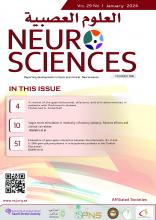Research ArticleOriginal Article
Open Access
Effects of decompressive craniectomy combined with edaravone on postoperative neurological functions and hemodynamics of patients with severe traumatic brain injury
Xinjing Yang
Neurosciences Journal January 2024, 29 (1) 25-31; DOI: https://doi.org/10.17712/nsj.2024.1.20230057
Xinjing Yang
From the Department of Neurosurgery, Medical College, Nanchang University, Nanchang, China
BSc
References
- 1.↵
- 2.↵
- Rakhit S,
- Nordness MF,
- Lombardo SR,
- Cook M,
- Smith L,
- Patel MB.
- 3.↵
- 4.↵
- Wang Z,
- Zhang R,
- Han Z,
- Wang J,
- Wu R,
- Zhao W, et al.
- 5.↵
- Wang H,
- He Y,
- Liang R,
- Wu X,
- Zhao L,
- Yang J, et al.
- 6.↵
- Gao Y,
- Duan J,
- Ji H,
- Lu W.
- 7.↵
- Robinson CP.
- 8.↵
- Câmara-Costa H,
- Francillette L,
- Opatowski M,
- Toure H,
- Brugel D,
- Laurent-Vannier A, et al.
- 9.↵
- Nakagawa A,
- Kudo D,
- Sonobe S,
- Mugikura S,
- Kushimoto S,
- Tominaga T.
- 10.↵
- Gao Y,
- Liao LP,
- Chen P,
- Wang K,
- Huang C,
- Chen Y, et al.
- 11.↵
- 12.
- Jin T,
- Lian W,
- Xu K,
- Liu Y,
- Xu Z,
- Lu R, et al.
- 13.↵
- Takahashi CE,
- Virmani D,
- Chung DY,
- Ong C,
- Cervantes-Arslanian AM.
- 14.↵
- 15.
- Vázquez Sánchez T,
- Gámez España JP,
- Martínez Esteban MD.
- 16.↵
- Ali Ali B,
- Brinck T,
- Handolin L,
- Belzunegui Otano T.
- 17.↵
- Schindler CR,
- Woschek M,
- Vollrath JT,
- Kontradowitz K,
- Lustenberger T,
- Störmann P, et al.
- 18.
- Godoy DA,
- Aguilera S,
- Rabinstein AA.
- 19.↵
- Lockey DJ,
- Wilson M.
- 20.↵
- Maiden MJ,
- Cameron PA,
- Rosenfeld JV,
- Cooper DJ,
- McLellan S,
- Gabbe BJ.
- 21.↵
- 22.↵
- Curry BW,
- Ward S,
- Lindsell CJ,
- Hart KW,
- McMullan JT.
- 23.↵
- Deng N,
- Xiao S,
- Zhong Y,
- Yao X.
- 24.↵
- Novack TA,
- Zhang Y,
- Kennedy R,
- Rapport LJ,
- Marwitz J,
- Dreer LE, et al.
- 25.↵
- Shi L,
- Han Y,
- Huang H,
- Davidsson J,
- Thomson R.
- 26.↵
- Mohamed Ludin S,
- Abdul Rashid N.
- 27.↵
- Vehviläinen J,
- Brinck T,
- Lindfors M,
- Numminen J,
- Siironen J,
- Raj R.
In this issue
Effects of decompressive craniectomy combined with edaravone on postoperative neurological functions and hemodynamics of patients with severe traumatic brain injury
Xinjing Yang
Neurosciences Journal Jan 2024, 29 (1) 25-31; DOI: 10.17712/nsj.2024.1.20230057
Jump to section
Related Articles
- No related articles found.
Cited By...
- No citing articles found.





